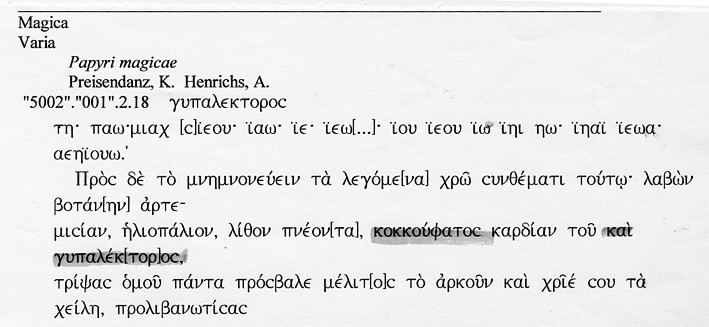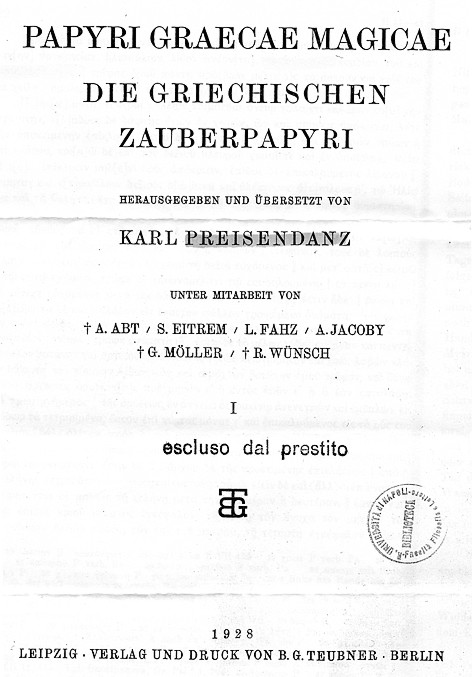Lessico
Papyri Graecae Magicae
e il fantasmagorico
Γυπαλέκτωρ
Secondo
quanto riferisce il web,
pare
che questi papiri risalgano a un periodo compreso
tra il II secolo aC e il V secolo dC.
The Greek Magical Papyri (papyri is plural of papyrus) (commonly abbreviated to PGM from the Latin title Papyri Graecae Magicae) is a collective term for a collection of texts, mostly in Ancient Greek, found on papyrus in the deserts of Egypt, which cast light in some way on the magico-religious syncretistic world of Greco-Roman Egypt and the surrounding area.
The Papyri
The papyri date mostly from the second century BCE to the fifth century or so CE. The corpus that makes up these papyri was first collected in the early twentieth century by German scholar Karl Preisendanz, and published by him in two volumes in 1928 and 1931. A projected third volume (containing new texts and indices) was destroyed during the bombing of Leipzig in the Second World War. The new texts were incorporated into the 1974 edition of volume II (published after Preisendanz's death), but the indices only ever circulated among scholars in a few xeroxed copies of the galley proofs. (The indices are now effectively obsolete since the PGM can now be searched in the Thesaurus Linguae Graecae database and various concordances and dictionaries have been published.)
Magic in Greco-Roman Egypt
Many of these pieces of papyrus are pages or fragmentary extracts from what we may call spell books, repositories of arcane knowledge and mystical secrets. As far as we can reconstruct them, these books appear to fall into two broad categories: some are compilations of spells and magical writings, gathered by scholarly collectors either out of academic interest or for some kind of study of magic; others may have been the working manuals of travelling magicians, containing their repertoire of spells, formulae for all occasions. These often poorly educated magic-users were more like showmen than the traditional Egyptian wizards, who were a highly educated and respected priestly elite. The pages contain spells, recipes, formulae and prayers, interspersed with magic words and often in shorthand, with abbreviations for the more common formulae. These spells range from impressive and mystical summonings of dark gods and daemons, to what we might call folk- or old-wives’ remedies and even parlour tricks; from portentous, fatal curses, to love charms, cures for impotence and minor medical complaints. In many cases the formulaic words and phrases are strikingly similar to those found in defixiones (spells) (curse tablets or binding spells, κατάδεσμοι in Greek), such as those we find inscribed on ostraka, amulets and lead tablets. Since some of these defixiones date from as early as the sixth century BCE, and have been found as far afield as Athens, Asia Minor, Rome and Sicily (as well as Egypt), this provides a degree of continuity and suggests that some observations based on the PGM will not be altogether inapplicable to the study of the wider Greco-Roman world.
Religion in Greco-Roman Egypt
The religion of the Papyri Graecae Magicae is an elaborate syncretism of Greek, Egyptian, Jewish, and even Babylonian and Christian religious influences engendered by the unique milieu of Greco-Roman Egypt. We see this syncretism in the Papyri in a variety of ways. Often the Olympians are given attributes of their Egyptian counterparts; alternatively we can see this as Egyptian deities being referred to by Greek names. For example Aphrodite (who was associated with the Egyptian Hathor), is given the epithet Neferie'ri - from the Egyptian Nfr-iry.t, "nice eyes" (PGM IV. 1266). Within this cacophony of cultural influences we can still see classical Greek material, and perhaps even identify aspects of a more accessible "folk-religion" than those preserved in the mainstream literary texts. Sometimes we see the Greek gods in a new light, they are demonic, bestial deities, much more Chthonic - earthly - than Olympian, and part of a darker, discomforting tradition to which we are unused. No doubt this is partly the influence of Egyptian religion, in which beast cult and the terror of the divine were familiar elements, and equally we see that the context of magical texts makes such sinister deities appropriate.
Bibliography
-
Preisendanz, K. et al. (1928-1931 first ed.) Papyri Graecae Magicae. Die
Griechischen Zauberpapyri. (2 vols)
- Preisendanz, K., Albert Henrichs (1974-1974 second ed.) Papyri Graecae
Magicae. Die Griechischen Zauberpapyri. (2 vols) Stuttgart: Teubner.
- Betz, H. D. et al. (1986) The Greek Magical Papyri in Translation.
Including the Demotic Texts. University of Chicago Press.
- Muñoz Delgado, L. (2001) Léxico de magia y religión en los papiros mágicos
griegos. Diccionario Griego-Español. Anejo V. Madrid: CSIC.
Although most of the magical papyri were discovered in Egypt the nineteenth century and brought together as part of the Anastasi Collection, they were not completely published until 1925. In fact, the first complete translation into English had to wait until 1986 (Betz).
It is quite likely that many of the papyri come from a single source, perhaps a tomb or temple library, and it is commonly supposed that they were collected by a Theban Magician. In any case, they are one of the best sources of Greco-Egyptian magic and religion, comparable to the Qumran scrolls for Judaism and the Nag Hamadi library for Gnosticism. We are extremely lucky that they have survived, since magical books and scrolls were often systematically burned (Acts 19:19; but not just by the Christians: Augustus ordered 2000 to be burned).
"The PGM (Papryi Graecae Magicae) is the name given to a cache of papryi of magical spells collected by Jean d'Anastaisi in early 1800's Egypt. Hans Deiter Betz, in his introduction to the newest English translation, speculates that these papyri may have been found in a tomb or temple library and the largest papyri may have been the collection of one man in Thebes. However, the exact provenance for the PGM is unknown. Betz states that through literary sources it is known that quite a number of magical books of spells were collected in ancient times, most of which were destroyed. Thus, the PGM are a very important source for first-hand information about magical practices in the ancient Mediterranean."
So the PGM have been written in the time that is now the beginning of our era. Very much the same periode as the writing of the Hermetic scriptures! And besides the PGM, there are also so-called Papyri Demoticae Magicae (PDM - also after the language they are written in).
Many of the PGM and PDM were discovered in the 19th century by the earlier mentioned diplomat and book-collector d'Anastasi who bought them from an unknown man from Thebes in Egypt. Later other collections and separate papyri were found or located. Unfortunately even the d'Anastasi library didn't remain together and was bought by different libraries in parts. The amount of papyri is still growing, but they are spread all over the world. Most of them where in the second Preisendanz translation, a few more in Betz, but since new texts keep popping up, a book will probably never be totally complete.
It is not for nothing that they were written on papyri (but also on metal, pots, plates, etc.), since they are Egyptian in origin. Both the magic and the texts are often very Egyptian. Also I dare to state that the papyri were written in Alexandria, just as the Hermetic scriptures. The reason for this is that the texts not only speak of Egyptian and Greek gods, but also very much of Jewish and sometimes Gnostic deities and several references are made to Persia and Persian and Babylonian gods. In that time this was possible in only one city.
www.monas.nl/think
Γυπαλέκτωρ
in
Papyri Graecae Magicae
secondo
D’Arcy Wentworth
THOMPSON
equivale
all'Upupa
A Glossary of Greek Birds
Georg Holms, Hildesheim, 1966 (1895)

Brano
relativo al Γυπαλέκτωρ
in
Papyri Graecae Magicae
messo
a disposizione
dal Professor Antonio Garzya![]()
Napoli - 2005

trascrizione del Professor Antonio Garzya
Anche secondo Karl Preisendanz
Γυπαλέκτωρ
in
Papyri Graecae Magicae
equivale
all'Upupa
in quanto il traduttore non conosceva
la mutazione Collo nudo del pollo![]()



Per serbare le parole nella memoria, c'è bisogno della seguente mistura: prendi la pianta di artemisia, la pietra opale solare, la pietra magnete, il cuore di un'upupa, che viene anche detto gallo avvoltoio, grattugia tutto insieme, aggiungi una sufficiente quantità di miele e ungi le tue labbra, dopo aver prima affumicato la bocca con un granello d'incenso.
Secondo
Elio
Corti
che conosce la mutazione Collo nudo del
pollo ![]()
Γυπαλέκτωρ
in
Papyri Graecae Magicae
corrisponde
al pollo Collo nudo
che è ben distinto dall'Upupa
traduzione dell'11 agosto 2006
Al
fine di non identificare erroneamente l'upupa con il pollo collo nudo
come giustamente esprime la traduzione di Preisendanz
d'accodo col Professor Roberto Ricciardi![]()
si propone di emendare
καρδίαν τοῦ
καὶ
con
καρδίαν
τε καὶ
che in modo inequivocabile
individua due uccelli completamente diversi
Πρὸς δὲ τὸ μνημνονεύειν τὰ λεγόμε[να] χρῶ συνθέματι τούτῳ· λαβὼν βοτάν[ην] ἀρτεμισίαν, ἡλιοπάλιον, λίθον πνέον[τα], κοκκούφατος καρδίαν {τοῦ} <τε> καὶ γυπαλέκ[τορ]ος, τρίψας ὁμοῦ πάντα πρόσβαλε μέλιτ[ο]ς τὸ ἀρκοῦν καὶ χρῖέ σου τὰ χείλη, προλιβανωτίσας τὸ στόμα χόνδρῳ λιβάνου.
Usa questo miscuglio per ricordare ciò che viene detto: dopo aver preso dell'erba artemisia, dell'opale color sole, della pietra che respira, un cuore di upupa e di gallo avvoltoio, trita tutto insieme, aggiungi quanto basta di miele e frizionati le labbra, dopo aver prima profumato d'incenso la bocca con un granello d'incenso.
Per questo emendamento del testo si è detto d'accordo anche il Professor Antonio Garzya in un colloquio telefonico svoltosi il 4 settembre 2006. Infatti Garzya ha analizzato altre ricette nel loro testo originale, e ha rilevato che non vengono mai addotti sinonimi dei vari ingredienti. Il motivo è semplice: non si tratta di un vocabolario oppure di un'enciclopedia. Chi trascriveva le ricette non era un dotto con intendimenti didattici: elencava i componenti senza dilungarsi in particolari del tutto inutili.
Come
ha giustamente puntualizzato il Professor Roberto Ricciardi, l'avvoltoio![]() e il
gallo avvoltoio
e il
gallo avvoltoio![]() nella ricetta di Ezio di Amida sono due uccelli nettamente distinti. In parole
povere: dal testo di Ezio non si può assolutamente arguire che il gallo
avvoltoio sia un sinonimo dell'avvoltoio, come invece parrebbe accadere nel
testo delle Papyri Graecae Magicae in cui il gallo avvoltoio viene inteso
come sinonimo dell'upupa. Ciò non accadrà più quando il testo del papiro
verrà ufficialmente emendato.
nella ricetta di Ezio di Amida sono due uccelli nettamente distinti. In parole
povere: dal testo di Ezio non si può assolutamente arguire che il gallo
avvoltoio sia un sinonimo dell'avvoltoio, come invece parrebbe accadere nel
testo delle Papyri Graecae Magicae in cui il gallo avvoltoio viene inteso
come sinonimo dell'upupa. Ciò non accadrà più quando il testo del papiro
verrà ufficialmente emendato.